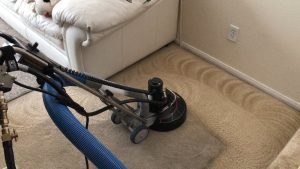Wet vs Dry Carpet Cleaning: Which Method is Right for You?
Carpet cleaning is an essential task that helps maintain the cleanliness and long life of your carpets. When it comes to cleaning carpets, there are primarily two methods: wet carpet cleaning and dry carpet cleaning. Each method has its advantages and considerations, and choosing the right one depends on various factors. In this article, we will explore the differences between wet and dry carpet cleaning and help you determine which method is suitable for your specific needs.
Introduction
Regular carpet cleaning is crucial to maintain a healthy indoor environment and extend the life of your carpets. Wet and dry carpet cleaning are the two carpet cleaning methods used by professionals to remove dirt, stains, and allergens from carpets. Understanding the differences between these methods will help you make an informed decision.
Wet Carpet Cleaning

The Process
Wet carpet cleaning, also known as steam carpet cleaning or hot water extraction carpet cleaning, involves injecting hot water mixed with cleaning solutions into the carpet fibers. The mixture is then extracted using a powerful vacuum, along with the dirt and debris accumulated in the carpet. This method effectively removes deep-seated dirt and allergens.
Pros of Wet Carpet Cleaning
- Deep cleaning: Wet carpet cleaning reaches the deepest layers of the carpet, removing embedded dirt, bacteria, and allergens that accumulate over time.
- Stain removal: This method is highly effective in removing stubborn stains and spots from the carpet fibers.
- Comprehensive cleaning: Wet cleaning covers the entire carpet area, ensuring a thorough and consistent cleaning result.
Cons of Wet Carpet Cleaning
- Longer drying time: Since wet cleaning involves water saturation, carpets may take several hours or even a day to dry completely.
- Risk of mold and mildew: If the carpet is not adequately dried, it can create a favorable environment for mold and mildew growth, leading to unpleasant odors and potential health risks.
- Unsuitable for some carpets: Certain types of carpets, such as wool or antique rugs, may not be suitable for wet cleaning due to the risk of shrinkage or color bleeding.
Dry Carpet Cleaning

The Process
Dry carpet cleaning methods utilize specialized cleaning compounds or powders that are applied to the carpet surface. These compounds attract and absorb dirt, which is then vacuumed away, leaving the carpet clean and fresh. Dry cleaning methods are typically faster and require less drying time compared to wet cleaning.
Pros of Dry Carpet Cleaning
- Quick drying: Using low-moisture techniques, dry carpet cleaning allows for fast drying, so you can use the cleaned areas almost immediately without waiting for extensive drying time.
- Convenience: Dry cleaning is a convenient option, especially for high-traffic areas or commercial settings where minimal disruption is desired. There’s no need to wait for carpets to dry, enabling prompt cleaning and use of the space.
- Reduced risk of damage: Dry methods minimize the risk of over-saturating carpet fibers, which can lead to shrinkage, color bleeding, or mold and mildew growth. This makes it safer for delicate or sensitive carpets.
- No detergent residue: Specialized cleaning compounds or powders used in dry carpet cleaning attract and encapsulate dirt and debris without the need for rinsing or extensive extraction. This reduces the chance of detergent residue remaining on the carpet.
- Targeted spot cleaning: Dry cleaning is effective for spot cleaning and treating specific areas or stains. The compounds can be applied directly to problem areas, allowing for precise cleaning and stain removal.
- Odor control: Dry carpet cleaning often incorporates deodorizing agents that neutralize unpleasant odors trapped in the carpet fibers, leaving them fresh and clean.
Cons of Dry Carpet Cleaning
- Limited stain removal: Dry cleaning may not be as effective as wet cleaning when it comes to removing deep-seated stains or heavily soiled areas.
- Surface-level cleaning: Dry cleaning primarily targets the surface of the carpet, so it may not penetrate deep into the fibers to remove all allergens or dirt.
- Residue buildup: If the dry cleaning compound is not properly vacuumed, it can leave behind residue, making the carpet feel sticky or attract more dirt in the future.
Factors to Consider
When deciding between wet and dry carpet cleaning, several factors should be taken into account:
Carpet Type and Condition
Consider the type and condition of your carpet. Some carpets, such as wool or antique oriental rugs, may require special care and may not be suitable for wet cleaning. Check the manufacturer’s recommendations or consult a las vegas henderson professional carpet cleaner to determine the best cleaning method for your specific carpet type.
Stain and Odor Removal
If your carpets have deep stains or persistent odors, wet cleaning is generally more effective. The hot water extraction process can penetrate the fibers and lift away stubborn stains and odors. However, for minor surface stains, dry cleaning methods may suffice.
Drying Time
Assess the drying time you can accommodate. Wet cleaning involves moisture saturation, which requires a longer drying time. If you need your carpets to dry quickly, dry cleaning methods offer a faster turnaround time.
Allergies and Sensitivities
Wet carpet cleaning uses hot water and chemicals to remove dirt and stains from the carpet fibers. with its thorough extraction of allergens, can be beneficial for individuals with respiratory issues or allergies. Dry carpet cleaning, on the other hand, maybe a suitable option for those who are sensitive to certain chemicals or moisture.
Cost and Convenience
Evaluate the cost and convenience factors. Wet cleaning is often performed by professional carpet cleaning services, which may come at a higher cost. Dry cleaning methods, such as DIY carpet cleaning powders, offer a more budget-friendly option. Additionally, dry cleaning allows for immediate use of the carpet after cleaning, whereas wet cleaning requires drying time.
10 Secrets Sparkling Home Unveil Best House Cleaning Services Las Vegas
Conclusion
Wet and dry carpet cleaning are both effective methods for cleaning your carpets. Wet cleaning excels in deep cleaning and stain removal, while dry cleaning offers convenience and faster drying times. Assess your carpet type, cleaning requirements, drying time constraints, allergies, and budget to determine the most suitable method for your needs. The best method for you will depend on your individual needs and preferences. If you are not sure which method is right for you, it is a good idea to talk to a professional carpet cleaning in Henderson Las Vagas Company.
6. FAQs
Q1: How often should I have my carpets professionally cleaned?
A1: It is generally recommended to have your carpets professionally cleaned every 12 to 18 months, depending on the level of foot traffic and the presence of pets or allergies.
Q2: Can I use wet cleaning on all types of carpets?
A2: While wet cleaning is suitable for most carpets, certain delicate fibers, such as wool or antique rugs, may require specialized dry cleaning methods. Check the manufacturer’s recommendations or consult a professional for guidance.
Q3: Will wet cleaning make my carpets shrink?
A3: Properly executed wet cleaning should not cause shrinkage. However, it is crucial to ensure that the carpet is thoroughly dried to prevent moisture-related issues.
Q4: Can dry cleaning remove deep stains from my carpets?
A4: Dry cleaning methods are more effective for surface-level stains. For deep-set stains, wet cleaning, particularly hot water extraction, is generally more successful.
Q5:How many hours does it take for the carpet to dry after cleaning?
A5: Wet-cleaned carpets will take 6-12 hours to dry completely. Dry-cleaned carpets will take 3-6 hours to dry completely. However, these are just estimates, and the actual drying time may vary depending on the factors mentioned above.
Q6:How long until I can walk on the carpet after cleaning?
A6: In general, you should wait at least 6 hours before walking on a wet-cleaned carpet. Cleaned carpets can usually be walked on after 6 hours. However, it is always best to err on the side of caution and wait longer.
Thank you for reading this article on wet vs. dry carpet cleaning. We hope this information has helped you understand the differences between the two methods and choose the right approach for your carpets. Remember to consider factors such as carpet type, cleaning requirements, drying time, allergies, and budget when making your decision.



